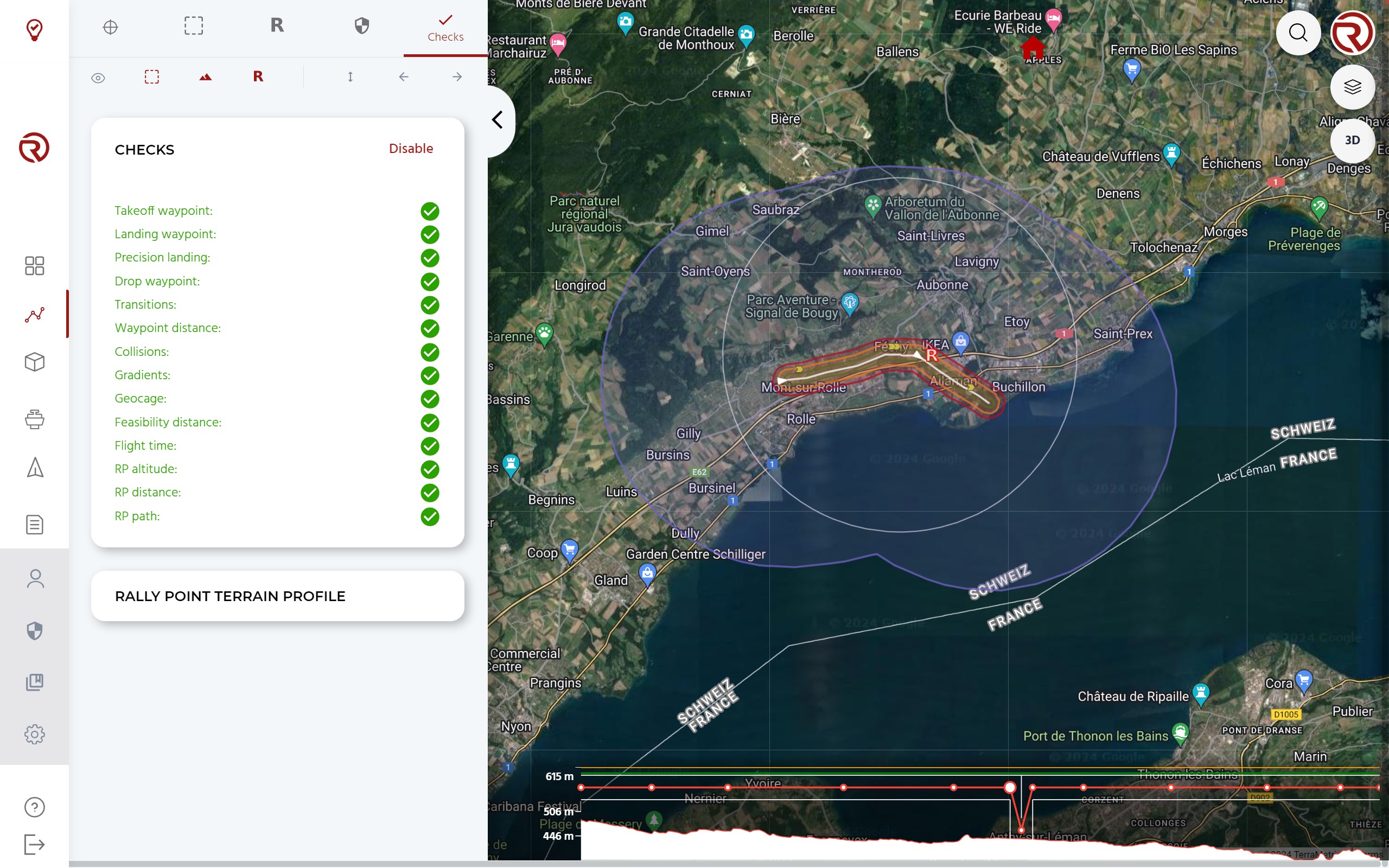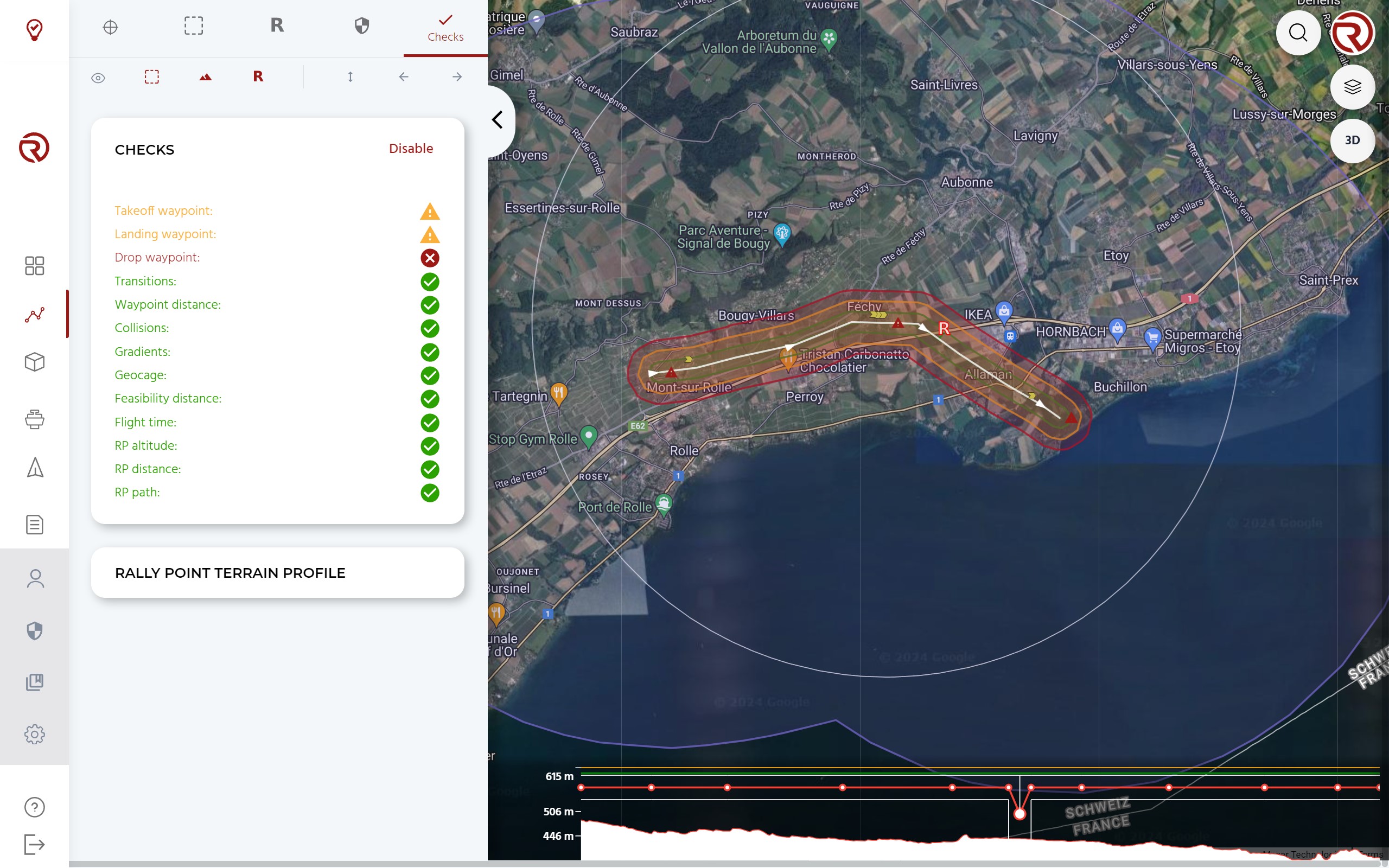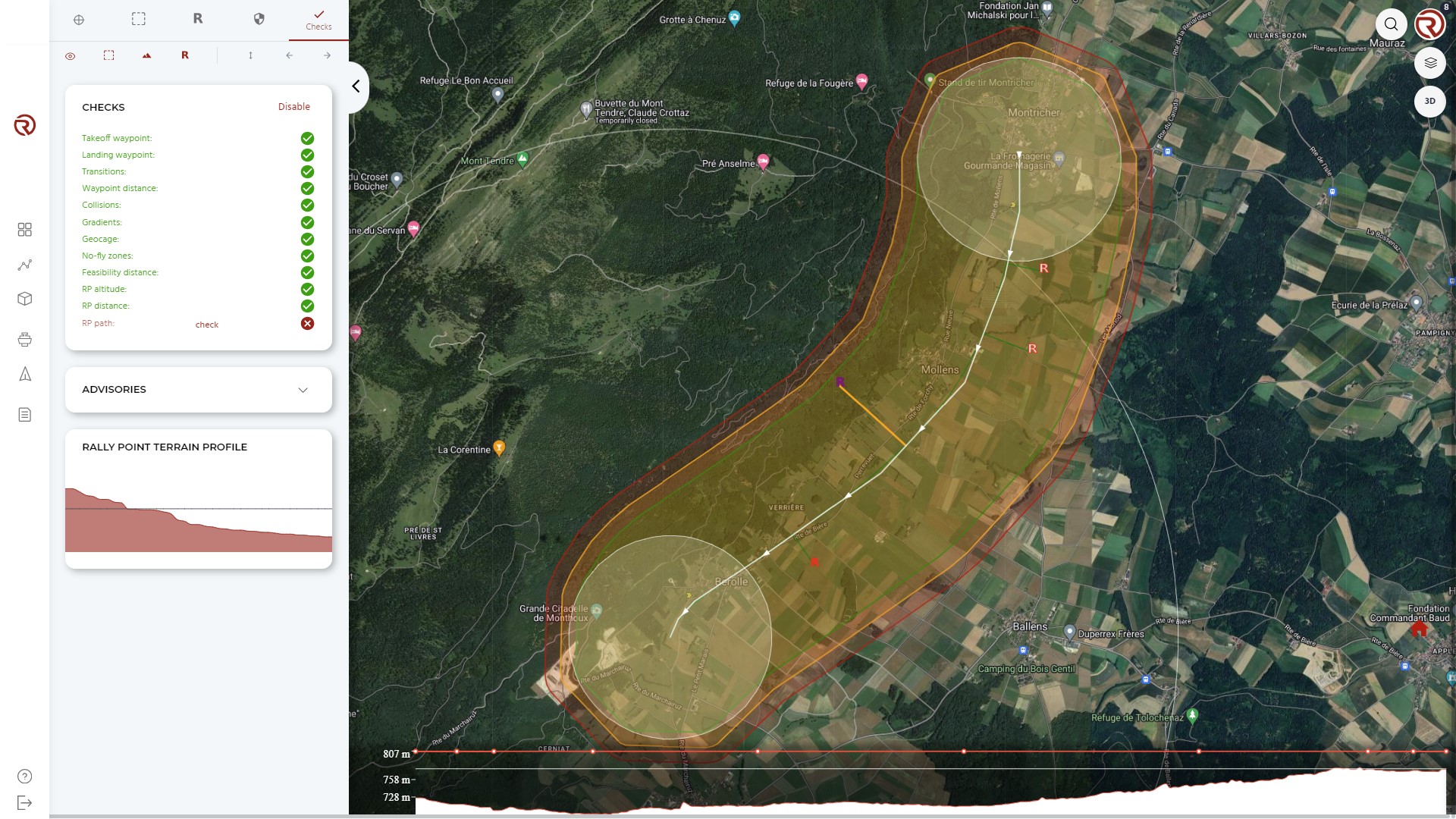Safety checks
Safety checks overview
Safety checks are a preliminary way to ensure that the flight plan is properly prepared by checking its structure (takeoff, landing and transitions, as well as gradients and possible collisions with the terrain) and safety elements (geocages and rally points).
Disclaimer:
- Although passing all the mandatory checks ensures a certain coherence of the route, passing them does not warranty that the route will be safe and no accidents will happen, since safety checks do not verify elements such as the weather, sharp turns, collisions with obstacles or airspace density.
- The operator shall ensure that the route is safe enough and suitable for the operation.
- RigiTech is not responsible for any decision taken by the operator due to the interpretation of the safety checks.
The following pictures contain examples of a route with all the checks passed while the second one includes warnings and checks not passed.

- List of safety checks: allows to see the status of the checks.
- Enable/Disable: enables/disables checks. This tool can be used to restart the checks in case of need.
- Rally point terrain profile: allows to see the terrain profile in the vertical slize of the path between a generic point of the flight plan and the rally point. See Rally Points Checks
- In order to see this profile, the user shall hover the mouse over a rally point path.

Not all the checks have the same importance. For example, there could be flights without a transition (if planned only in multicopter), but takeoff and landing points are definitely needed.
Takeoff waypoint
Checks if the flight plan starts with a takeoff waypoint and if there are multiple takeoff waypoints.
Passing this check is mandatory
A warning will also be displayed if the pad altitude is below ground. In this case, the check can be neglected, as long as the pad altitude has been measured and validated by the operator.
Landing waypoint
Checks if the flight plan ends with a landing waypoint and if there are multiple landing waypoints.
Passing this check is mandatory.
A warning will also be displayed if the pad altitude is below ground. In this case, the check can be neglected, as long as the pad altitude has been measured and validated by the operator.
Drop waypoint
Checks the structure of the "Drop" waypoint. A warning will be displayed if:
- There is more than one "Drop" waypoint.
- The "Drop" waypoint is in a fixed-wing section.
- The Approach altitude and the Pad altitude are too close (< 20 m).
- The Approach altitude and the Pad altitude are too far (> 20 m).
- The Approach altitude is below the "Drop height above target".
Passing this check is mandatory.
A warning will also be displayed if the pad altitude is below ground. In this case, the check can be neglected, as long as the pad altitude has been measured and validated by the operator.
Note: This check is available only if a "Drop" waypoint is used in the flight plan.
Transitions
Checks if the transitions are correct, both in order and in distance. The check will not be passed if:
- The number of transition points is uneven.
- The order of the transitions in the route is not "front" and "back" transitions.
- The distance of the transitions is not enough.
- Front transition: 250 m
- Back transition: 250 m
- The takeoff point is too far from the front transition point (1000 m).
- The landing point is too far from the back transition point (1000 m).
- One or both transitions points are too close from ground (altitude < 30 m AGL).
Passing this check is recommended. However, when there is not enough space to execute the transitions with enough distance, it might be acceptable not to pass it (only if the causes are the distances) as long as the operator has evaluated the consequences of a shorter transition distance within their operational context.
Waypoint distance
Checks if the maximum distance between checkpoints is respected (5000 m).
Passing this check is mandatory.
Collisions
Checks if there are collisions with the terrain (only ground level + 15 m, no obstacles are taken into account).
Passing this check is mandatory.
Gradients
Checks the gradients of the waypoints (4º or 4 m/s of vertical speed while flying at 29 m/s in fixed-wing configuration).
Passing this check is generally mandatory. However, if there is enough space for the UAS (both in containment and presence of obstacles) to execute a helicoidal climbing and/or descent, it might be acceptable not to pass this check when the operator is confident that the execution of the operation will be safe and adequate.
Geocage
Checks if there is a geocage and a pregeocage in the route (warning) and, in case of having one of each, if there is a violation of it (check not passed).
Passing this check is mandatory.
Feasibility distance
Checks if the route distance is below the maximum distance (100 km).
Passing this check is mandatory.
Flight time
Checks if the estimated flight time is below the maximum endurance of the UA (59 min).
Passing this check is mandatory.
Rally Points checks
- RP altitude: checks if the Rally Point altitudes are acceptable.
- RP distance: checks maximum distance of all the generic points of the the flight plan to the closest rally point (1000 m by default, but it can be changed by requesting it to RigiTech).
- RP path: checks if there are potential collisions between the generic points of the flight plan and the path towards the closest rally point.
- Green path: the distance between the path and the rally point is within the predefined limit (10000 m by default, but it can be changed by requesting it to RigiTech) and there are no collisions between the path and the terrain.
- Yellow path: acceptable distance, but collisions with the terrain.
- Red path: no collisions with the terrain, but distance above the limits.
- Purple path: collisions with the terrain and distance above the limits.

Passing these checks depend on the standard and contingency procedures and the expected use of SRP or Smart Rally Point manoeuvre.
- It can be acceptable not to pass the RP distance safecty check if the flight plan is structured in such a way that it is reasonable to expect that the SRP manoeuvre will be executed in fixed-wing. Otherwise, if the rally point is too far in multicopter, an emergency landing will likely be triggered automatically.
- If the use of SRP as a contingency measure is expected, ensuring that the RP paths are correct is mandatory.
Interpretation and importance of safety checks
The following checks are mandatory and need to be passed:
- Takeoff waypoint (with the potential exception of the pad altitude under ground)
- Landing waypoint (with the potential exception of the pad altitude under ground)
- Waypoint distance
- Collisions
- Gradients (with exceptions)
- Geocage
- Feasibility distance
- Flight time
The following checks depend on the flight plan and the operational context:
- Transition
- Rally Points checks